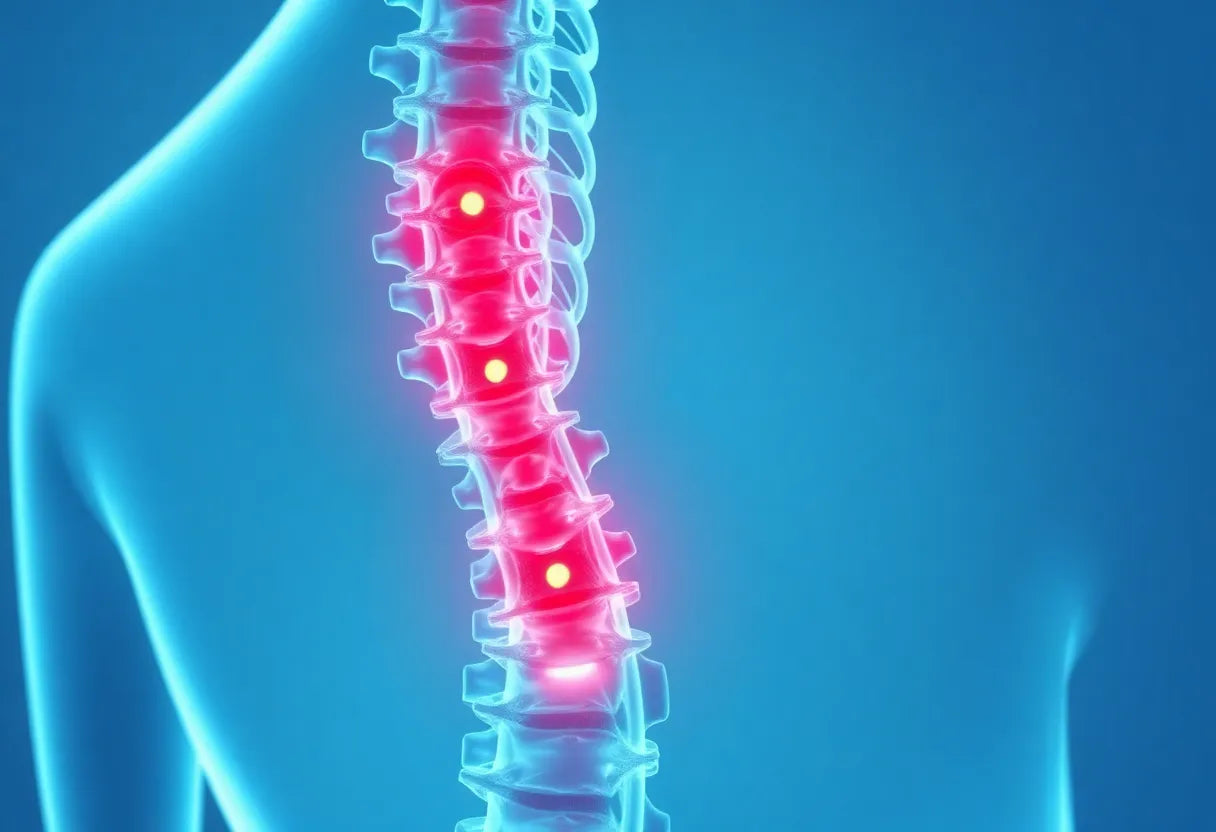Understanding the early signs of a herniated disc is crucial for maintaining spinal health and preventing long-term complications. A herniated disc, often referred to as a slipped or ruptured disc, occurs when the soft center of a spinal disc pushes through a crack in the tougher exterior casing. This condition can lead to pain, numbness, or weakness in the back, neck, or limbs, significantly impacting an individual's overall health and well-being.
Recognizing the early signs of a herniated disc is essential for timely intervention, which can prevent chronic pain and disability. Early detection allows for treatment options that can alleviate symptoms and improve quality of life. Unfortunately, many people dismiss initial signs as minor back pain, delaying diagnosis and treatment. This common misconception can lead to more severe issues if left unaddressed, highlighting the importance of understanding and identifying early symptoms.
Why early detection is essential
Early detection of a herniated disc can significantly influence treatment outcomes. When identified promptly, conservative treatments such as physical therapy, medication, and lifestyle changes can be highly effective. These interventions can reduce the risk of chronic pain and the potential need for surgical procedures. On the other hand, ignoring early warning signs can result in prolonged discomfort and, in severe cases, permanent nerve damage.
Many people mistakenly attribute back pain to muscle strain or fatigue, which can delay seeking medical advice. This delay can exacerbate the condition, leading to more severe symptoms and complications. Understanding the nuances of back pain and recognizing when it could indicate a herniated disc is crucial for preventing long-term issues.
Are you noticing subtle symptoms?
Consider this: Have you ever experienced a sharp pain in your lower back after lifting something heavy, or felt a tingling sensation running down your leg? These could be subtle signs of a herniated disc. Often, early symptoms are mild and easily overlooked, but they are your body's way of signaling a potential problem. Reflect on your experiences with back pain—are they more frequent or intense than before? Recognizing these early signs can make a significant difference in your spinal health journey.
By paying attention to these subtle indicators, you can take proactive steps to address the issue before it escalates. Understanding the early signs of a herniated disc empowers you to seek appropriate care and make informed decisions about your health, ultimately leading to better outcomes and a healthier spine.
localized pain and muscle spasms: early indicators
One of the earliest signs of a herniated disc is localized pain, which often manifests in the back or neck. This pain can be sharp or dull, and its intensity may vary depending on the activity level or body position. Muscle spasms frequently accompany this pain, serving as a protective response to the irritation caused by the herniated disc. These spasms can lead to stiffness and restricted movement, making it difficult to perform everyday tasks. Recognizing these initial symptoms is crucial, as they are often the body's first warning signals of a potential disc issue.

Lumbar support belt
Stabilizes and relieves lower back pain; ideal for sciatica and herniated discs.
radiating pain and nerve compression
Another key early sign of a herniated disc is radiating pain, which occurs when the herniated material presses against nearby nerves. This can lead to pain that extends beyond the localized area, often traveling down the arms or legs, depending on the affected disc's location. For instance, a herniated disc in the lower back may cause sciatica, characterized by pain running down the leg. This symptom is a clear indication of nerve compression, which can worsen if not addressed promptly. Understanding how a herniated disc affects nerve pathways is essential for identifying and treating the condition early.

numbness and weakness in limbs
Numbness and weakness in the limbs can also serve as early warning signs of a herniated disc. These symptoms occur when the herniated disc compresses nerves that control muscle function and sensation. Individuals may experience difficulty in performing daily activities, such as lifting objects, walking, or maintaining balance. For example, a person might notice a weakened grip or an inability to hold onto items securely. These subtle changes in strength and sensation should not be ignored, as they can indicate a more serious underlying issue.
common early signs vs. severe symptoms
Understanding the difference between early signs and severe symptoms of a herniated disc is vital for effective intervention. Early signs such as localized pain, mild numbness, and occasional weakness can often be managed with conservative treatments. However, if these symptoms progress to chronic pain, significant loss of sensation, or persistent muscle weakness, more intensive interventions may be necessary. Recognizing these distinctions allows for timely medical evaluation and appropriate treatment, preventing the condition from escalating.
| Early Signs | Severe Symptoms |
|---|---|
| Localized pain | Chronic pain |
| Mild numbness | Significant loss of sensation |
| Occasional weakness | Persistent muscle weakness |
By recognizing and understanding these early indicators, individuals can take proactive steps to address a herniated disc before it leads to more severe complications. Early detection and intervention are key to maintaining spinal health and preventing long-term issues.
lifestyle and ergonomic solutions for spinal health
To support spinal health and minimize the risk of a herniated disc, incorporating ergonomic adjustments into your daily routine is essential. At work, ensure your chair supports your lower back and that your computer screen is at eye level to prevent neck strain. Similarly, at home, consider investing in a mattress that supports proper spinal alignment. These changes can significantly reduce the stress on your spine.

Men's Posture Shirt™ - Black
Improves posture, relieves back pain, and activates muscles during daily use.
In addition to ergonomic improvements, adopting a lifestyle that includes regular exercise and proper posture is crucial. Engaging in activities that strengthen core muscles, such as yoga or pilates, can provide additional support to your spine. Maintaining good posture, whether sitting, standing, or lifting, reduces the likelihood of disc strain and promotes overall spinal health.
preventive measures to avoid herniated discs
Preventing a herniated disc involves a combination of maintaining a healthy weight and avoiding activities that place undue stress on your back. Excess weight can increase the pressure on spinal discs, so a balanced diet and regular physical activity are vital for weight management. Additionally, be mindful of body mechanics when lifting heavy objects. Use your legs for lifting and avoid twisting motions that can strain your back.
Incorporating simple exercises into your routine can also play a significant role in prevention. Activities like swimming, walking, or cycling can enhance cardiovascular health without placing excessive stress on the spine. Specific exercises targeting the back and core, such as planks or bridges, can strengthen these areas, providing better support and reducing the risk of injury.
concluding thoughts on early detection and intervention
Listening to your body and recognizing early signs of a herniated disc is critical for maintaining spinal health. Early detection and intervention can prevent the progression of symptoms and reduce the likelihood of chronic pain or disability. By being proactive about your spinal health, you can make informed decisions and seek medical advice when necessary, ultimately leading to better outcomes and a healthier spine.
The benefits of early detection are clear: timely medical evaluation can lead to effective treatment options, minimizing discomfort and preventing severe complications. Emphasizing the importance of early intervention can empower individuals to take control of their health and ensure long-term spinal well-being.
frequently asked questions
What are the first signs of a herniated disc?
The first signs of a herniated disc often include localized pain, radiating pain, numbness, and muscle weakness. These symptoms can vary in intensity and may be accompanied by muscle spasms.
Can a herniated disc heal on its own?
In some cases, a herniated disc can heal with rest and proper care. Symptoms may improve over time, but it is essential to consult a healthcare professional for a tailored treatment plan.
How is a herniated disc diagnosed?
A herniated disc is typically diagnosed through a combination of physical exams, imaging tests like MRI or CT scans, and an evaluation of symptoms. A healthcare provider will assess these factors to determine the best course of action.
What treatments are available for a herniated disc?
Treatment options for a herniated disc range from conservative approaches like physical therapy and medications to surgical intervention, depending on the severity of the condition. A healthcare provider can recommend the most suitable treatment based on individual needs.
How can I prevent a herniated disc?
Preventing a herniated disc involves maintaining a healthy lifestyle, using ergonomic aids, and practicing good posture and body mechanics. Regular exercise and weight management are also crucial in reducing the risk of disc strain.
Kilder
- COSM Clinic (n.d.). "Four Warning Signs of a Herniated Disc."
- ISPP Center (n.d.). "Spotting the Warning Signs of a Herniated Disc."
- Lamis Institute (n.d.). "8 Herniated Disc Symptoms You Should Know."
- Dr. Gentile MD (n.d.). "What Does a Herniated Disc Feel Like?"
- Core Orthosports (n.d.). "5 Unexpected Symptoms of a Herniated Disc."
- Penn Medicine (n.d.). "Herniated Disc Disorders."
- Hospital for Special Surgery (n.d.). "Herniated Disc."
- Cleveland Clinic (n.d.). "Herniated Disk."
- Florida Surgery Consultants (n.d.). "5 Common Symptoms of a Herniated Disc in the Neck."


















